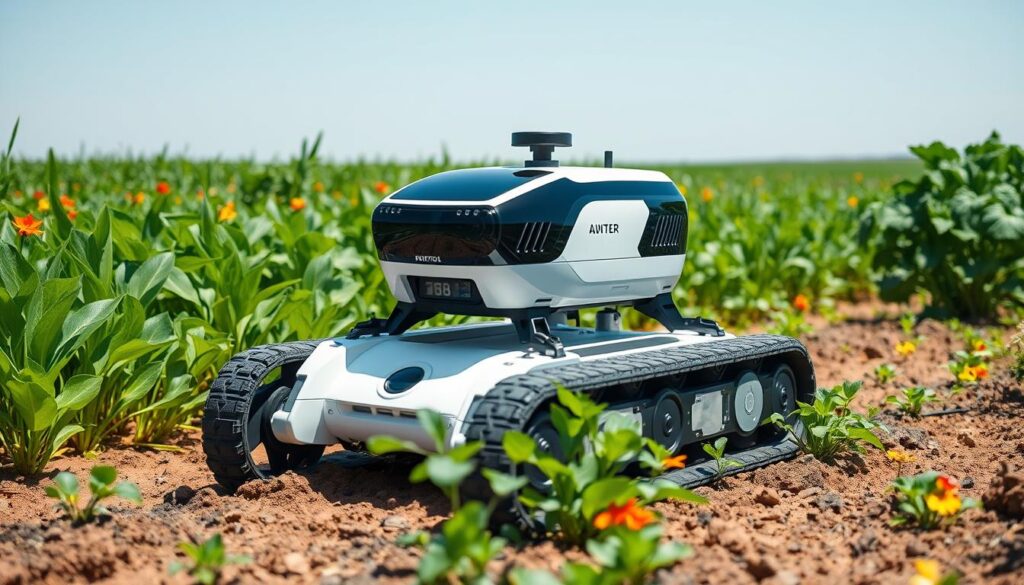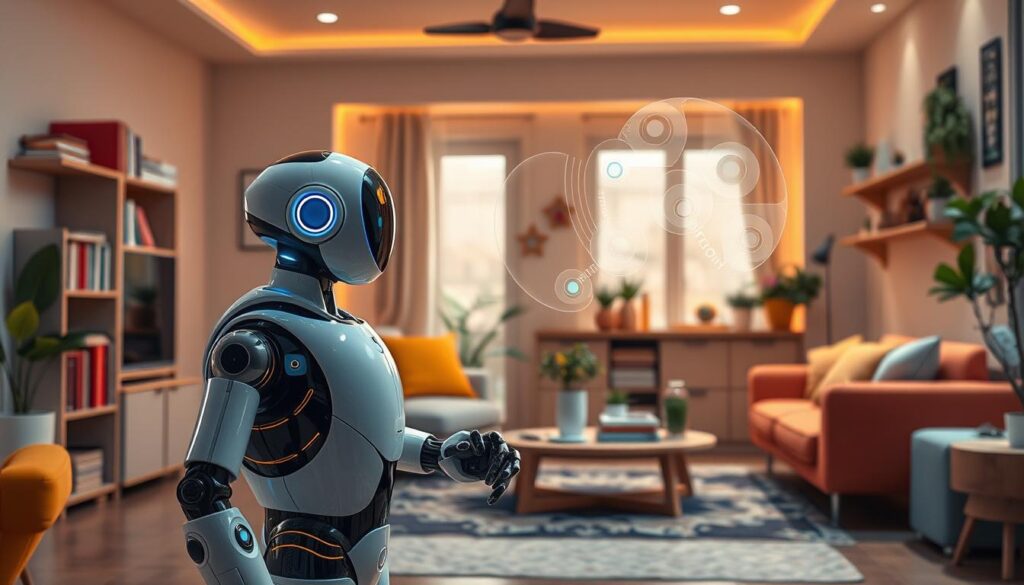Computer vision is key for home robots to see and understand their world. It lets them recognize and interact with different objects. This makes them more useful and improves how we use them.
Home robots can do many things, like moving things around and helping with tasks. They can even learn to assist us in our own way.
Home robots use artificial intelligence and machine learning to see and know objects. They can tell what things are and how to act around them. This helps them move safely and work well with us.
As robotics gets better, so does computer vision. This means home robots are getting smarter and more helpful. Soon, they’ll be a big part of our daily lives, making things easier and more fun.
Introduction to Computer Vision in Robotics
Computer vision is a key part of artificial intelligence. It lets machines understand digital images and videos. In robotics, it’s crucial for robots to see and understand their world. This technology is key for robots to move on their own, find objects, and recognize them.
Key Applications of Computer Vision in Robotics
Robotics in many fields like manufacturing, healthcare, and logistics use computer vision. It helps robots sort, manage inventory, and check quality. Also, it’s used for Simultaneous Localization and Mapping (SLAM) to make detailed 3D maps. This helps robots navigate better in new or changing places.
Autonomous Navigation and Mapping
Computer vision is key for robots to move on their own and map their surroundings. With SLAM technology, robots can create 3D maps of their area. This lets them move safely and efficiently, even in complex places. It’s vital for tasks like automated transport, warehouse management, and disaster response.
Object Detection and Recognition
Computer vision is great for robots to find and know objects. This is important for sorting, managing inventory, and checking quality. Robots use advanced algorithms and machine learning to spot and sort many objects. This helps them interact better with their environment.
Home Robot Development with Computer Vision
Computer vision has made home robots much better at understanding human actions. They can now use gestures and body language to get commands. This makes them more helpful around the house.
Gestures and Human Pose Recognition
Home robots can spot different gestures like pointing and waving. This lets users control them with simple hand movements. They also track body movements to better understand what we do.
Facial and Emotion Recognition
These robots can also read facial expressions and emotions. They can tell how we’re feeling and change their actions to match. This is great for helping the elderly or those who need extra care.
Computer vision has really changed how home robots work. They can now interact with us in a more natural way. As smart home devices become more popular, these features will be key to their success.
Augmented and Virtual Reality Integration
Computer vision, augmented reality (AR), and virtual reality (VR) are changing how home robots talk to us. AR and VR let home robots add digital stuff to the real world. This makes experiences more fun and interactive.
A study from 2007 to 2017 found AR helps learning. Students using AR in labs had less stress and learned more about electrical circuits. This shows AR can make learning better.
Engineering students who used AR did better in hands-on skills. A study with 36 students showed AR helped them learn robot operation. They did much better than those who didn’t use AR.
Students liked using AR for robot path planning. A workshop showed AR helps understand robot systems. It also boosts thinking skills.
| Study | Findings |
|---|---|
| Meta-analysis (2007-2017) | Learning with AR positively impacts learning outcomes |
| AR in instructional laboratories | Lower cognitive load for students compared to traditional lab formats |
| AR-supported learning in electrical circuits | Higher conceptual knowledge gains |
| AR environments in engineering education | Significant advantages in operation skills and higher appreciation |
| AR for robot operation (36 students) | Significantly higher achievements in experimental group |
| AR tools for mobile robot path planning | Appreciation for understanding robot systems and integrative thinking |
This mix of augmented reality, virtual reality, and home robots makes experiences better. It changes how we interact with these robots.
Agricultural and Home Automation Robotics
Computer vision is making big strides in agricultural and home automation robotics. Farmers are using robots with computer vision to boost crop yields. Home systems are also getting smarter, thanks to robots that can do tasks like security and cleaning.
These robots can see, understand, and act on their surroundings. This makes them more useful and efficient.
Robotic Vision for Home Robots
In home automation robotics, computer vision is leading to big improvements. Robots can now understand gestures, human poses, and even emotions. This lets them help people in a more natural way.
For example, Tortuga AgTech’s robots pick fruit with 98% accuracy, needing only one person to supervise. Harvest CROO’s robot can pick strawberries in eight seconds and move to the next in just over a minute. These robots show how robotic vision can change farming and reduce hard work.
| Company | Technology | Capability |
|---|---|---|
| FFRobotics | Robotic fruit harvester | 10 times faster than human pickers; funded by the European Union’s Horizon research program |
| Carbon Robotics | LaserWeeder | Uses AI and computer vision for weed control, improving crop quality while reducing costs |
| Scythe Robotics | M.52 mower | Has a dozen sensors for 360-degree perception and advanced AI for obstacle navigation |
The use of robotic vision in agricultural robotics and home automation shows how computer vision is changing things. As technology gets better, we’ll see robots doing even more amazing things. They will change how we do farming and household chores.

Key Technologies Enabling Computer Vision
The growth of computer vision comes from several key technologies. These include image recognition algorithms and the use of machine learning and neural networks. Image recognition algorithms help robots see and understand objects. Machine learning and neural networks, like CNNs, let these systems get better over time.
This mix of technologies is key for home robots to know and react to their surroundings. It makes their actions smarter and more flexible.
Image Recognition Algorithms
Image recognition algorithms are the heart of computer vision. They let robots spot and sort out objects in their space. These algorithms use methods like feature extraction and deep learning to make sense of what they see.
By improving these algorithms, experts are making home robots better at moving around, talking to us, and helping out.
Machine Learning and Neural Networks
Machine learning and neural networks are changing how robots see and interact with the world. Convolutional neural networks, for example, are great at finding objects, breaking down images, and understanding scenes. By learning from huge amounts of data, home robots can get to know their environment better.
This lets them adjust and respond to new situations more accurately and quickly.
The blend of image recognition algorithms and machine learning/neural networks is speeding up computer vision in robotics. As home robots become more common in our lives, these tech advances will be key. They will help these robots do more and interact with us in a smarter, more natural way.
Challenges and Future Advancements
Computer vision has made big steps in helping home robots understand their surroundings. But, there are still challenges to overcome. These include managing different lighting, dealing with complex backgrounds, and processing information quickly and accurately.
The future of computer vision in robotics is bright. New technologies like edge computing and the Internet of Things (IoT) are making systems more integrated and smart. As computer vision gets easier to use and scale, it will be used more in different fields. This will lead to new innovations and change how home robots work.
Companies like Agility, Boston Dynamics, Figure, Prosper, Sanctuary, and Tesla are working on humanoid robots. These robots use advanced computer vision and learning to understand objects, gestures, and human poses. This makes their interactions with us more natural and easy.
Researchers are also looking into Large X Models (LXMs). These are foundation models that can be fine-tuned for specific tasks. LXMs could make training robots much faster, improving efficiency and reducing mistakes.
There are also plans to use natural language interfaces and generative AI. These technologies aim to make data entry easier and improve accuracy. As they get better, computer vision and robotics will change how we live and work.
| Challenges | Future Advancements |
|---|---|
|
|

Conclusion
Computer vision has changed how home robots work. They can now see, understand, and interact with their world in new ways. Thanks to advanced tech, they can spot objects, read gestures, and even feel emotions.
As computer vision grows, so does the future of home robots. They will get smarter, more flexible, and better at working with us. This could change how we live and work for the better.
The market for household robots is growing fast. It was worth USD 6.81 billion in 2020 and is expected to grow even more. The smart home market is also booming, set to reach USD 135.3 billion by 2025.
This growth shows people want robots that make their lives easier. They want robots that can recognize objects, talk to them, and work with smart homes.
Robots like cleaning and educational ones are becoming more popular. Thanks to computer vision, home robots can now do many tasks. They can even learn and teach us things.
Robots like Dobb-E and Stretch show how robots can fit into our lives. They make our homes and communities better by working with us. This is the future of home robots.

